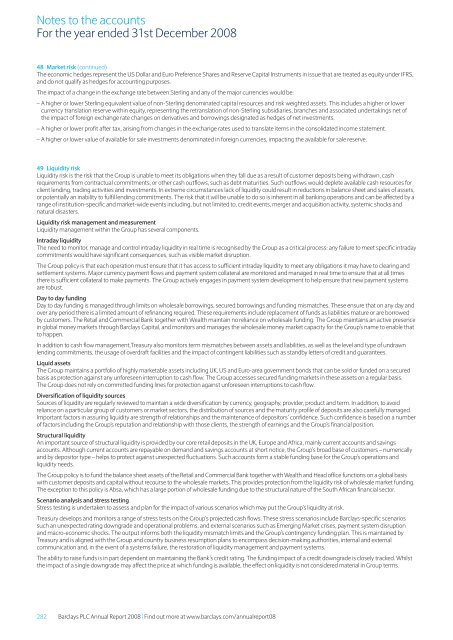Barclays plc - Annual Report 2008 - Financial statements - The Group
Barclays plc - Annual Report 2008 - Financial statements - The Group
Barclays plc - Annual Report 2008 - Financial statements - The Group
Create successful ePaper yourself
Turn your PDF publications into a flip-book with our unique Google optimized e-Paper software.
Notes to the accounts<br />
For the year ended 31st December <strong>2008</strong><br />
48 Market risk (continued)<br />
<strong>The</strong> economic hedges represent the US Dollar and Euro Preference Shares and Reserve Capital Instruments in issue that are treated as equity under IFRS,<br />
and do not qualify as hedges for accounting purposes.<br />
<strong>The</strong> impact of a change in the exchange rate between Sterling and any of the major currencies would be:<br />
– A higher or lower Sterling equivalent value of non-Sterling denominated capital resources and risk weighted assets. This includes a higher or lower<br />
currency translation reserve within equity, representing the retranslation of non-Sterling subsidiaries, branches and associated undertakings net of<br />
the impact of foreign exchange rate changes on derivatives and borrowings designated as hedges of net investments.<br />
– A higher or lower profit after tax, arising from changes in the exchange rates used to translate items in the consolidated income statement.<br />
– A higher or lower value of available for sale investments denominated in foreign currencies, impacting the available for sale reserve.<br />
49 Liquidity risk<br />
Liquidity risk is the risk that the <strong>Group</strong> is unable to meet its obligations when they fall due as a result of customer deposits being withdrawn, cash<br />
requirements from contractual commitments, or other cash outflows, such as debt maturities. Such outflows would deplete available cash resources for<br />
client lending, trading activities and investments. In extreme circumstances lack of liquidity could result in reductions in balance sheet and sales of assets,<br />
or potentially an inability to fulfil lending commitments. <strong>The</strong> risk that it will be unable to do so is inherent in all banking operations and can be affected by a<br />
range of institution-specific and market-wide events including, but not limited to, credit events, merger and acquisition activity, systemic shocks and<br />
natural disasters.<br />
Liquidity risk management and measurement<br />
Liquidity management within the <strong>Group</strong> has several components.<br />
Intraday liquidity<br />
<strong>The</strong> need to monitor, manage and control intraday liquidity in real time is recognised by the <strong>Group</strong> as a critical process: any failure to meet specific intraday<br />
commitments would have significant consequences, such as visible market disruption.<br />
<strong>The</strong> <strong>Group</strong> policy is that each operation must ensure that it has access to sufficient intraday liquidity to meet any obligations it may have to clearing and<br />
settlement systems. Major currency payment flows and payment system collateral are monitored and managed in real time to ensure that at all times<br />
there is sufficient collateral to make payments. <strong>The</strong> <strong>Group</strong> actively engages in payment system development to help ensure that new payment systems<br />
are robust.<br />
Day to day funding<br />
Day to day funding is managed through limits on wholesale borrowings, secured borrowings and funding mismatches. <strong>The</strong>se ensure that on any day and<br />
over any period there is a limited amount of refinancing required. <strong>The</strong>se requirements include replacement of funds as liabilities mature or are borrowed<br />
by customers. <strong>The</strong> Retail and Commercial Bank together with Wealth maintain no reliance on wholesale funding. <strong>The</strong> <strong>Group</strong> maintains an active presence<br />
in global money markets through <strong>Barclays</strong> Capital, and monitors and manages the wholesale money market capacity for the <strong>Group</strong>’s name to enable that<br />
to happen.<br />
In addition to cash flow management,Treasury also monitors term mismatches between assets and liabilities, as well as the level and type of undrawn<br />
lending commitments, the usage of overdraft facilities and the impact of contingent liabilities such as standby letters of credit and guarantees.<br />
Liquid assets<br />
<strong>The</strong> <strong>Group</strong> maintains a portfolio of highly marketable assets including UK, US and Euro-area government bonds that can be sold or funded on a secured<br />
basis as protection against any unforeseen interruption to cash flow. <strong>The</strong> <strong>Group</strong> accesses secured funding markets in these assets on a regular basis.<br />
<strong>The</strong> <strong>Group</strong> does not rely on committed funding lines for protection against unforeseen interruptions to cash flow.<br />
Diversification of liquidity sources<br />
Sources of liquidity are regularly reviewed to maintain a wide diversification by currency, geography, provider, product and term. In addition, to avoid<br />
reliance on a particular group of customers or market sectors, the distribution of sources and the maturity profile of deposits are also carefully managed.<br />
Important factors in assuring liquidity are strength of relationships and the maintenance of depositors’ confidence. Such confidence is based on a number<br />
of factors including the <strong>Group</strong>’s reputation and relationship with those clients, the strength of earnings and the <strong>Group</strong>’s financial position.<br />
Structural liquidity<br />
An important source of structural liquidity is provided by our core retail deposits in the UK, Europe and Africa, mainly current accounts and savings<br />
accounts. Although current accounts are repayable on demand and savings accounts at short notice, the <strong>Group</strong>’s broad base of customers – numerically<br />
and by depositor type – helps to protect against unexpected fluctuations. Such accounts form a stable funding base for the <strong>Group</strong>’s operations and<br />
liquidity needs.<br />
<strong>The</strong> <strong>Group</strong> policy is to fund the balance sheet assets of the Retail and Commercial Bank together with Wealth and Head office functions on a global basis<br />
with customer deposits and capital without recourse to the wholesale markets. This provides protection from the liquidity risk of wholesale market funding.<br />
<strong>The</strong> exception to this policy is Absa, which has a large portion of wholesale funding due to the structural nature of the South African financial sector.<br />
Scenario analysis and stress testing<br />
Stress testing is undertaken to assess and plan for the impact of various scenarios which may put the <strong>Group</strong>’s liquidity at risk.<br />
Treasury develops and monitors a range of stress tests on the <strong>Group</strong>’s projected cash flows. <strong>The</strong>se stress scenarios include <strong>Barclays</strong>-specific scenarios<br />
such an unexpected rating downgrade and operational problems, and external scenarios such as Emerging Market crises, payment system disruption<br />
and macro-economic shocks. <strong>The</strong> output informs both the liquidity mismatch limits and the <strong>Group</strong>’s contingency funding plan. This is maintained by<br />
Treasury and is aligned with the <strong>Group</strong> and country business resumption plans to encompass decision-making authorities, internal and external<br />
communication and, in the event of a systems failure, the restoration of liquidity management and payment systems.<br />
<strong>The</strong> ability to raise funds is in part dependent on maintaining the Bank’s credit rating. <strong>The</strong> funding impact of a credit downgrade is closely tracked. Whilst<br />
the impact of a single downgrade may affect the price at which funding is available, the effect on liquidity is not considered material in <strong>Group</strong> terms.<br />
282 <strong>Barclays</strong> PLC <strong>Annual</strong> <strong>Report</strong> <strong>2008</strong> | Find out more at www.barclays.com/annualreport08

















